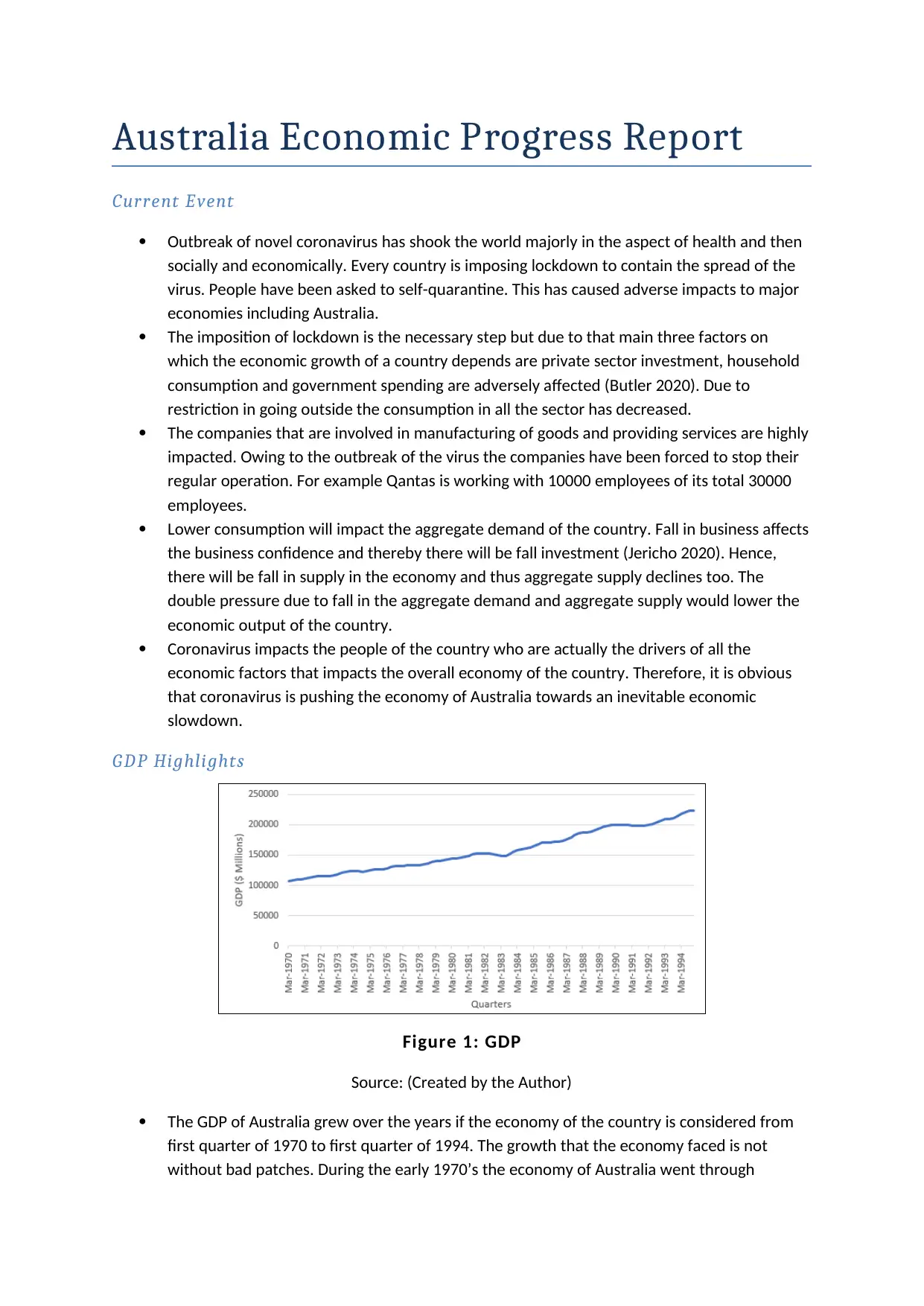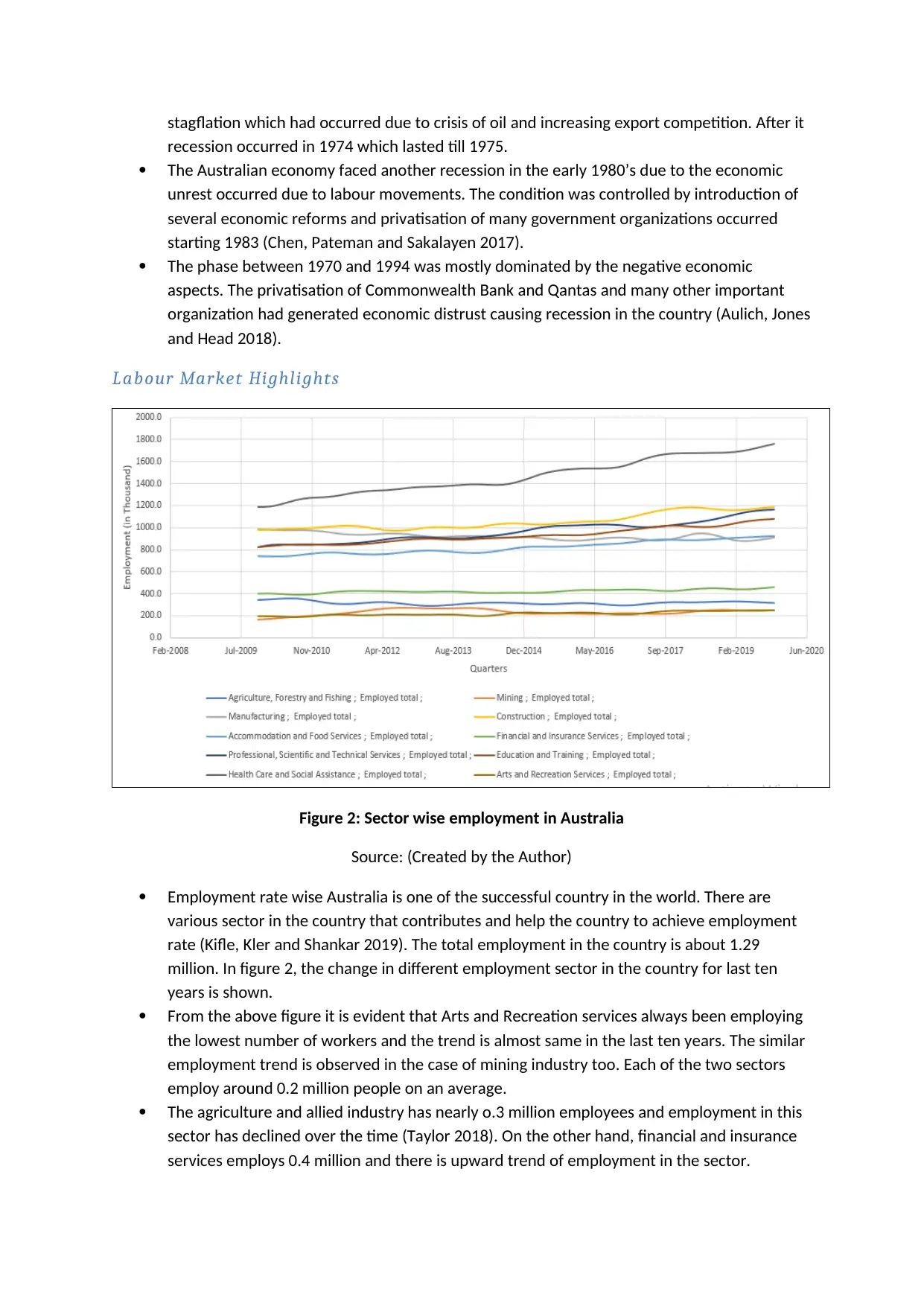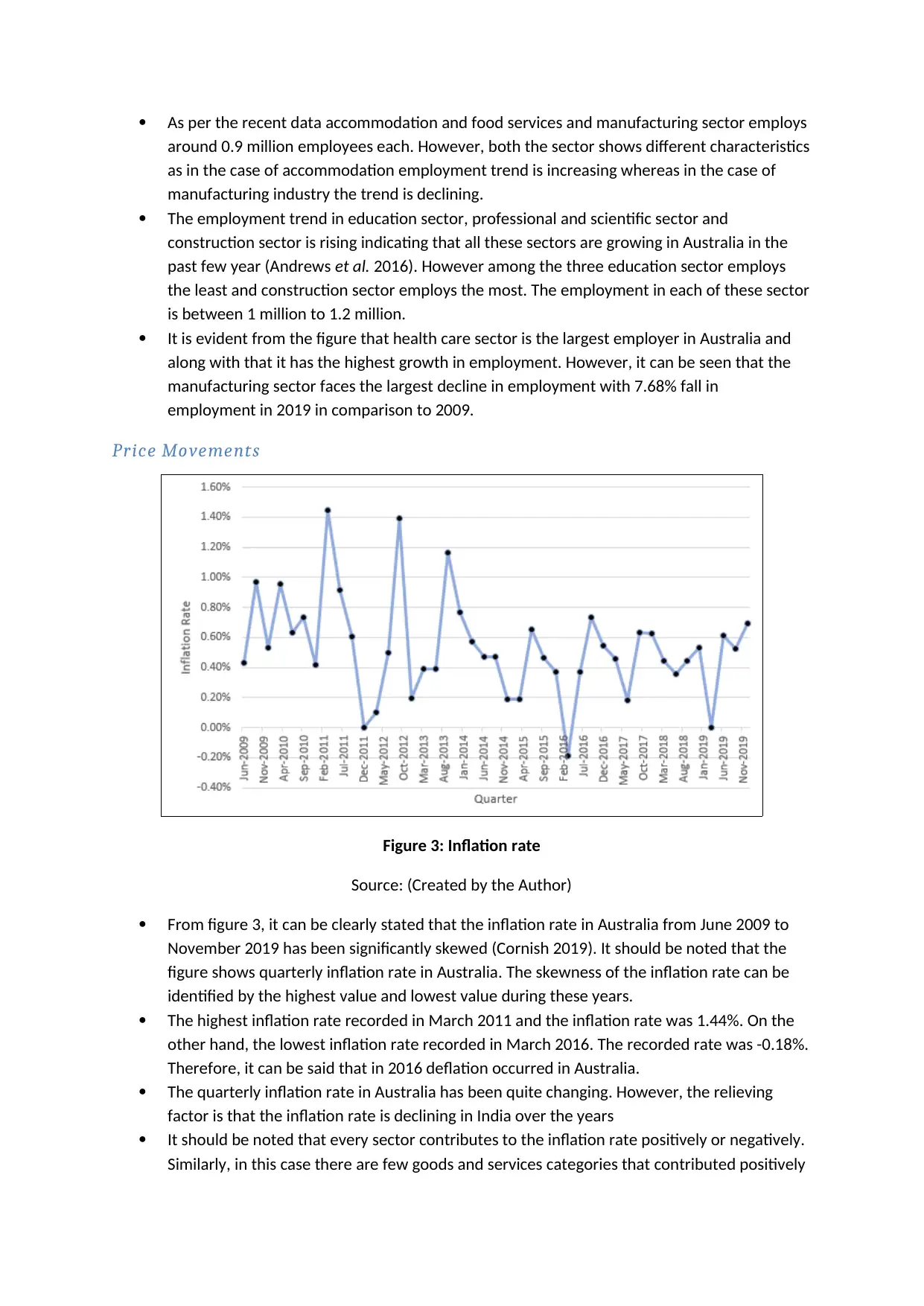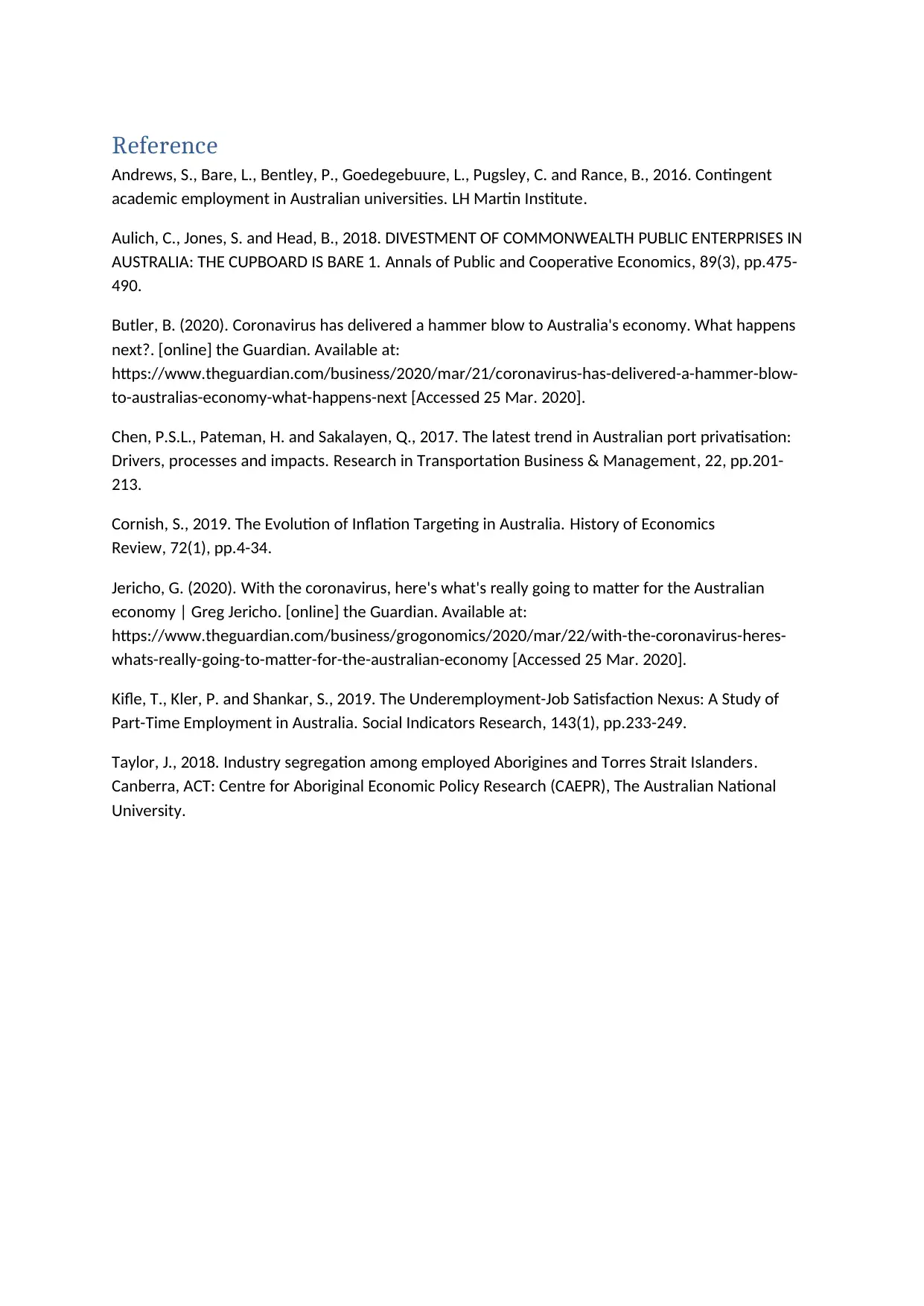Australia Economic Progress Report | Study
VerifiedAdded on 2022/08/29
|5
|1364
|16
AI Summary
Contribute Materials
Your contribution can guide someone’s learning journey. Share your
documents today.

Australia Economic Progress Report
Current Event
Outbreak of novel coronavirus has shook the world majorly in the aspect of health and then
socially and economically. Every country is imposing lockdown to contain the spread of the
virus. People have been asked to self-quarantine. This has caused adverse impacts to major
economies including Australia.
The imposition of lockdown is the necessary step but due to that main three factors on
which the economic growth of a country depends are private sector investment, household
consumption and government spending are adversely affected (Butler 2020). Due to
restriction in going outside the consumption in all the sector has decreased.
The companies that are involved in manufacturing of goods and providing services are highly
impacted. Owing to the outbreak of the virus the companies have been forced to stop their
regular operation. For example Qantas is working with 10000 employees of its total 30000
employees.
Lower consumption will impact the aggregate demand of the country. Fall in business affects
the business confidence and thereby there will be fall investment (Jericho 2020). Hence,
there will be fall in supply in the economy and thus aggregate supply declines too. The
double pressure due to fall in the aggregate demand and aggregate supply would lower the
economic output of the country.
Coronavirus impacts the people of the country who are actually the drivers of all the
economic factors that impacts the overall economy of the country. Therefore, it is obvious
that coronavirus is pushing the economy of Australia towards an inevitable economic
slowdown.
GDP Highlights
Figure 1: GDP
Source: (Created by the Author)
The GDP of Australia grew over the years if the economy of the country is considered from
first quarter of 1970 to first quarter of 1994. The growth that the economy faced is not
without bad patches. During the early 1970’s the economy of Australia went through
Current Event
Outbreak of novel coronavirus has shook the world majorly in the aspect of health and then
socially and economically. Every country is imposing lockdown to contain the spread of the
virus. People have been asked to self-quarantine. This has caused adverse impacts to major
economies including Australia.
The imposition of lockdown is the necessary step but due to that main three factors on
which the economic growth of a country depends are private sector investment, household
consumption and government spending are adversely affected (Butler 2020). Due to
restriction in going outside the consumption in all the sector has decreased.
The companies that are involved in manufacturing of goods and providing services are highly
impacted. Owing to the outbreak of the virus the companies have been forced to stop their
regular operation. For example Qantas is working with 10000 employees of its total 30000
employees.
Lower consumption will impact the aggregate demand of the country. Fall in business affects
the business confidence and thereby there will be fall investment (Jericho 2020). Hence,
there will be fall in supply in the economy and thus aggregate supply declines too. The
double pressure due to fall in the aggregate demand and aggregate supply would lower the
economic output of the country.
Coronavirus impacts the people of the country who are actually the drivers of all the
economic factors that impacts the overall economy of the country. Therefore, it is obvious
that coronavirus is pushing the economy of Australia towards an inevitable economic
slowdown.
GDP Highlights
Figure 1: GDP
Source: (Created by the Author)
The GDP of Australia grew over the years if the economy of the country is considered from
first quarter of 1970 to first quarter of 1994. The growth that the economy faced is not
without bad patches. During the early 1970’s the economy of Australia went through
Secure Best Marks with AI Grader
Need help grading? Try our AI Grader for instant feedback on your assignments.

stagflation which had occurred due to crisis of oil and increasing export competition. After it
recession occurred in 1974 which lasted till 1975.
The Australian economy faced another recession in the early 1980’s due to the economic
unrest occurred due to labour movements. The condition was controlled by introduction of
several economic reforms and privatisation of many government organizations occurred
starting 1983 (Chen, Pateman and Sakalayen 2017).
The phase between 1970 and 1994 was mostly dominated by the negative economic
aspects. The privatisation of Commonwealth Bank and Qantas and many other important
organization had generated economic distrust causing recession in the country (Aulich, Jones
and Head 2018).
Labour Market Highlights
Figure 2: Sector wise employment in Australia
Source: (Created by the Author)
Employment rate wise Australia is one of the successful country in the world. There are
various sector in the country that contributes and help the country to achieve employment
rate (Kifle, Kler and Shankar 2019). The total employment in the country is about 1.29
million. In figure 2, the change in different employment sector in the country for last ten
years is shown.
From the above figure it is evident that Arts and Recreation services always been employing
the lowest number of workers and the trend is almost same in the last ten years. The similar
employment trend is observed in the case of mining industry too. Each of the two sectors
employ around 0.2 million people on an average.
The agriculture and allied industry has nearly o.3 million employees and employment in this
sector has declined over the time (Taylor 2018). On the other hand, financial and insurance
services employs 0.4 million and there is upward trend of employment in the sector.
recession occurred in 1974 which lasted till 1975.
The Australian economy faced another recession in the early 1980’s due to the economic
unrest occurred due to labour movements. The condition was controlled by introduction of
several economic reforms and privatisation of many government organizations occurred
starting 1983 (Chen, Pateman and Sakalayen 2017).
The phase between 1970 and 1994 was mostly dominated by the negative economic
aspects. The privatisation of Commonwealth Bank and Qantas and many other important
organization had generated economic distrust causing recession in the country (Aulich, Jones
and Head 2018).
Labour Market Highlights
Figure 2: Sector wise employment in Australia
Source: (Created by the Author)
Employment rate wise Australia is one of the successful country in the world. There are
various sector in the country that contributes and help the country to achieve employment
rate (Kifle, Kler and Shankar 2019). The total employment in the country is about 1.29
million. In figure 2, the change in different employment sector in the country for last ten
years is shown.
From the above figure it is evident that Arts and Recreation services always been employing
the lowest number of workers and the trend is almost same in the last ten years. The similar
employment trend is observed in the case of mining industry too. Each of the two sectors
employ around 0.2 million people on an average.
The agriculture and allied industry has nearly o.3 million employees and employment in this
sector has declined over the time (Taylor 2018). On the other hand, financial and insurance
services employs 0.4 million and there is upward trend of employment in the sector.

As per the recent data accommodation and food services and manufacturing sector employs
around 0.9 million employees each. However, both the sector shows different characteristics
as in the case of accommodation employment trend is increasing whereas in the case of
manufacturing industry the trend is declining.
The employment trend in education sector, professional and scientific sector and
construction sector is rising indicating that all these sectors are growing in Australia in the
past few year (Andrews et al. 2016). However among the three education sector employs
the least and construction sector employs the most. The employment in each of these sector
is between 1 million to 1.2 million.
It is evident from the figure that health care sector is the largest employer in Australia and
along with that it has the highest growth in employment. However, it can be seen that the
manufacturing sector faces the largest decline in employment with 7.68% fall in
employment in 2019 in comparison to 2009.
Price Movements
Figure 3: Inflation rate
Source: (Created by the Author)
From figure 3, it can be clearly stated that the inflation rate in Australia from June 2009 to
November 2019 has been significantly skewed (Cornish 2019). It should be noted that the
figure shows quarterly inflation rate in Australia. The skewness of the inflation rate can be
identified by the highest value and lowest value during these years.
The highest inflation rate recorded in March 2011 and the inflation rate was 1.44%. On the
other hand, the lowest inflation rate recorded in March 2016. The recorded rate was -0.18%.
Therefore, it can be said that in 2016 deflation occurred in Australia.
The quarterly inflation rate in Australia has been quite changing. However, the relieving
factor is that the inflation rate is declining in India over the years
It should be noted that every sector contributes to the inflation rate positively or negatively.
Similarly, in this case there are few goods and services categories that contributed positively
around 0.9 million employees each. However, both the sector shows different characteristics
as in the case of accommodation employment trend is increasing whereas in the case of
manufacturing industry the trend is declining.
The employment trend in education sector, professional and scientific sector and
construction sector is rising indicating that all these sectors are growing in Australia in the
past few year (Andrews et al. 2016). However among the three education sector employs
the least and construction sector employs the most. The employment in each of these sector
is between 1 million to 1.2 million.
It is evident from the figure that health care sector is the largest employer in Australia and
along with that it has the highest growth in employment. However, it can be seen that the
manufacturing sector faces the largest decline in employment with 7.68% fall in
employment in 2019 in comparison to 2009.
Price Movements
Figure 3: Inflation rate
Source: (Created by the Author)
From figure 3, it can be clearly stated that the inflation rate in Australia from June 2009 to
November 2019 has been significantly skewed (Cornish 2019). It should be noted that the
figure shows quarterly inflation rate in Australia. The skewness of the inflation rate can be
identified by the highest value and lowest value during these years.
The highest inflation rate recorded in March 2011 and the inflation rate was 1.44%. On the
other hand, the lowest inflation rate recorded in March 2016. The recorded rate was -0.18%.
Therefore, it can be said that in 2016 deflation occurred in Australia.
The quarterly inflation rate in Australia has been quite changing. However, the relieving
factor is that the inflation rate is declining in India over the years
It should be noted that every sector contributes to the inflation rate positively or negatively.
Similarly, in this case there are few goods and services categories that contributed positively

and few contributed negatively. The top three goods and services category that contributed
most to the inflation rate are alcohol and tobacco, health sector and education sector.
most to the inflation rate are alcohol and tobacco, health sector and education sector.
Secure Best Marks with AI Grader
Need help grading? Try our AI Grader for instant feedback on your assignments.

Reference
Andrews, S., Bare, L., Bentley, P., Goedegebuure, L., Pugsley, C. and Rance, B., 2016. Contingent
academic employment in Australian universities. LH Martin Institute.
Aulich, C., Jones, S. and Head, B., 2018. DIVESTMENT OF COMMONWEALTH PUBLIC ENTERPRISES IN
AUSTRALIA: THE CUPBOARD IS BARE 1. Annals of Public and Cooperative Economics, 89(3), pp.475-
490.
Butler, B. (2020). Coronavirus has delivered a hammer blow to Australia's economy. What happens
next?. [online] the Guardian. Available at:
https://www.theguardian.com/business/2020/mar/21/coronavirus-has-delivered-a-hammer-blow-
to-australias-economy-what-happens-next [Accessed 25 Mar. 2020].
Chen, P.S.L., Pateman, H. and Sakalayen, Q., 2017. The latest trend in Australian port privatisation:
Drivers, processes and impacts. Research in Transportation Business & Management, 22, pp.201-
213.
Cornish, S., 2019. The Evolution of Inflation Targeting in Australia. History of Economics
Review, 72(1), pp.4-34.
Jericho, G. (2020). With the coronavirus, here's what's really going to matter for the Australian
economy | Greg Jericho. [online] the Guardian. Available at:
https://www.theguardian.com/business/grogonomics/2020/mar/22/with-the-coronavirus-heres-
whats-really-going-to-matter-for-the-australian-economy [Accessed 25 Mar. 2020].
Kifle, T., Kler, P. and Shankar, S., 2019. The Underemployment-Job Satisfaction Nexus: A Study of
Part-Time Employment in Australia. Social Indicators Research, 143(1), pp.233-249.
Taylor, J., 2018. Industry segregation among employed Aborigines and Torres Strait Islanders.
Canberra, ACT: Centre for Aboriginal Economic Policy Research (CAEPR), The Australian National
University.
Andrews, S., Bare, L., Bentley, P., Goedegebuure, L., Pugsley, C. and Rance, B., 2016. Contingent
academic employment in Australian universities. LH Martin Institute.
Aulich, C., Jones, S. and Head, B., 2018. DIVESTMENT OF COMMONWEALTH PUBLIC ENTERPRISES IN
AUSTRALIA: THE CUPBOARD IS BARE 1. Annals of Public and Cooperative Economics, 89(3), pp.475-
490.
Butler, B. (2020). Coronavirus has delivered a hammer blow to Australia's economy. What happens
next?. [online] the Guardian. Available at:
https://www.theguardian.com/business/2020/mar/21/coronavirus-has-delivered-a-hammer-blow-
to-australias-economy-what-happens-next [Accessed 25 Mar. 2020].
Chen, P.S.L., Pateman, H. and Sakalayen, Q., 2017. The latest trend in Australian port privatisation:
Drivers, processes and impacts. Research in Transportation Business & Management, 22, pp.201-
213.
Cornish, S., 2019. The Evolution of Inflation Targeting in Australia. History of Economics
Review, 72(1), pp.4-34.
Jericho, G. (2020). With the coronavirus, here's what's really going to matter for the Australian
economy | Greg Jericho. [online] the Guardian. Available at:
https://www.theguardian.com/business/grogonomics/2020/mar/22/with-the-coronavirus-heres-
whats-really-going-to-matter-for-the-australian-economy [Accessed 25 Mar. 2020].
Kifle, T., Kler, P. and Shankar, S., 2019. The Underemployment-Job Satisfaction Nexus: A Study of
Part-Time Employment in Australia. Social Indicators Research, 143(1), pp.233-249.
Taylor, J., 2018. Industry segregation among employed Aborigines and Torres Strait Islanders.
Canberra, ACT: Centre for Aboriginal Economic Policy Research (CAEPR), The Australian National
University.
1 out of 5
Related Documents
Your All-in-One AI-Powered Toolkit for Academic Success.
+13062052269
info@desklib.com
Available 24*7 on WhatsApp / Email
![[object Object]](/_next/static/media/star-bottom.7253800d.svg)
Unlock your academic potential
© 2024 | Zucol Services PVT LTD | All rights reserved.




